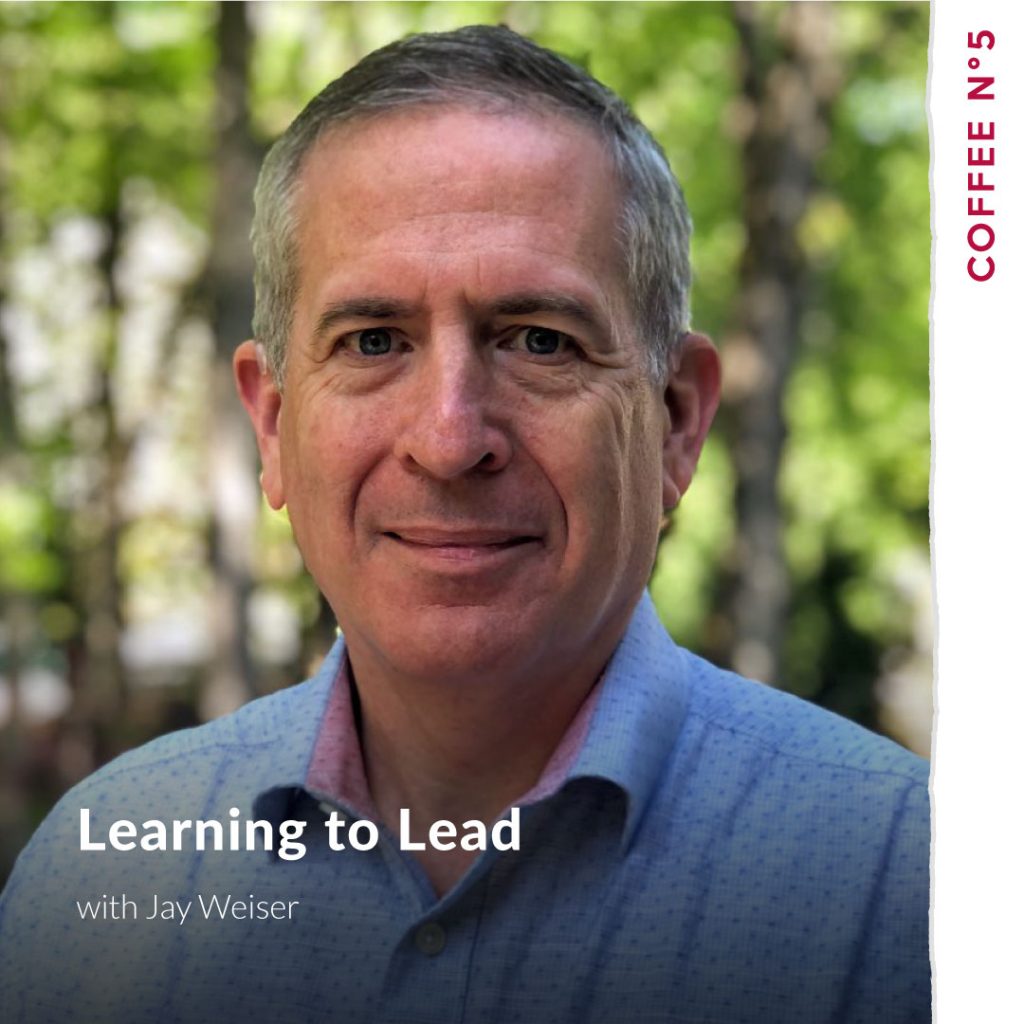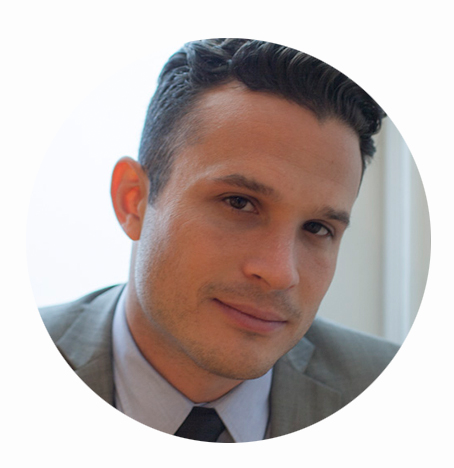Coffee N5_JayRWeiser
Lara Schmoisman 00:05
This is coffee N5. I’m your host, Laura Shmoisman. We are live on Facebook. Thank you everyone for being back here on coffee N5. Everyone knows how hard for me was to start this journey as an entrepreneur and how important it was for me to hire a team. And I talked about this so many times and I was interviewed about this. I mean, guys know that I believe in creating a culture by a company culture by design, that we need to plan before we decide how our company is going to be, and how we’re gonna interact with our team. Today, I want to talk to something really close to my heart. And these is leadership. for that. We have Jay Weiser, Weiser, Weiser, I always get it wrong. And it’s a Latino accent. So Jay Weiser. And welcome, Jay, thank you so much for being here. And first of all, I want to know more about yourself, and how did you become an expert? And how did you come up with these five leadership superpowers?
Jay Weiser 01:02
Weiser, So first of all, thank you very much for having me. And, you know, in terms of, you know, how did I get to where I am what I How did I become an expert. I’ve been consulting now for 25 plus years. And I’ve always worked with executives on how to help them execute and manage their strategy. And as I’ve done that, I’ve noticed most issues are not technical issues or operational issues. There are people issues, communication issues, leadership issues. Fast forward. Over the last year and a half the world has been disrupted. Before that there were other disruptions, whether 911, whether it was the great recession, whether it’s a storm, there’s always something going on. And it made me think about what different leadership capabilities are needed to help leaders thrive in a disruptive and uncertain environment, as well as when that’s not so disruptive.
Lara Schmoisman 02:29
So, okay, it took a moment that you thought about this, and you came up with five, not six, not for five.
Jay Weiser 02:39
For those people who know me, they’re like, no, Jay, he really didn’t come up with five, you probably came up with 20. And there were a lot, I started with three. And those three were present you trust, experience, learner, and strategic executer. Now you’ll notice those are all paradoxes. They’re opposites. And in today’s world, you’ve got to be able to do both. And think it’s not either this or that. Your customers expect both. Your clients expect both. So I was really good at coming up with paradoxes. And I those were picked up individually. And then I said, well, what’s needed to help leaders Excel, what’s different, you know, you always need their communication skills, waning skills, have improved great vision, and all those things, but what’s different? And as I started to condense, I said, you know, five is a good number five superpowers that kind of resonated. I was trying to come up with something I said, superpowers, that’s that extra, is that extra power. It’s that extra energy is how I came up with superpowers. And, excuse me, the fiber present futurist, experience learner prepared, risk taker, strategic executer in accountable collaborator, and they each have a little bit of a story behind them.
Lara Schmoisman 04:18
Okay, can you give us a little bit of brief explanation of each one of them, and why and why is important in leadership?
Jay Weiser 04:27
Absolutely. So the first one is present few trust. In a present futurist has to understand what’s happening today, you have to understand the environment, you have to understand the context, they have to understand the state of their business, but at the same time, they have to be able to look out into the future, envision where they’re going in at the same time, think about what trends are likely to happen, what events could disrupt their plans, and think about different possibility. And it’s balancing that tension. That’s so critical. Because if the leader is only focused in the present, you’re going to be too short sighted, if you’re only focused in the future is going to sound dreamy, and not anchored in reality. So having both really gives them a much more robust picture of what a leader needs to be thinking about sharing with their organizations, so they understand what’s happening. Being Next one is experienced learner. And that was kind of interesting, and how it originated, I wrote an article, maybe about two years back, called kill experience and expertise be poisonous to your career. And the point underlying that is, you can’t just rely on expertise and experience what you did before what you used to do, because that’s not going to solve today and tomorrow’s problems. So you have to use that experience and expertise, but at the same time, be open to continuous learning, being open mind going out, and we excuse me, reading live, like listening to different speakers. So it’s a combination that helps people get through challenging times new opportunities.
Lara Schmoisman 06:23
Let me ask your questions. Because I see that there’s something very common right now in executives. That is, I know it all. And I have all i’m sure you saw it too. And you know, I have no filter for those things. And I think that what you’re saying about learning is so important. I mean, most of my nights, I’m learning something, I either learning the new algorithms or something new, I just need to do it. But I being so close minded for me, to be able to lead my team means that I’m learning all the time. So I know what to expect from my team as well. If I’m not there to challenge them, and then challenged me back, there is no team there is no leadership there is like, is a synergy constantly with your team?
Jay Weiser 07:16
Absolutely. Staying, I know it all is the absolute worst thing a leader can say is when you say I know it all, you shut everybody else down, you don’t get that creativity, you don’t get the feedback, the market information, frontline information that you really need to hear. Second, when something like COVID hits, or something like the Great Recession, something comes out of the blue or seemingly out of the blue, you can’t know it all, you haven’t seen it before. So you have to be open to learning. And executives that were really good about this, instead of saying I know it all. They allow themselves to be vulnerable and say, I don’t know, to their people. But if they’re doing it right, but I’m confident that we together can figure this out. So it’s that reassurance, and is that openness that invites other people in? That’s so critical?
Lara Schmoisman 08:16
I absolutely agree i have i in my company have something that for each one of our clients, we do something every month that is called a blue sky. And I don’t care if it’s an executive, something about in the director level or someone an intern, anyone who is involved in the in the account is in that blue sky. Because I believe that each person, from their point of view, see their account a little different. And because of the what they learn and from their expertise, their age, where they’re located in the wall, everyone can bring something valid to the table, then it will be my prerogative to decide if I wanted to put it in this strategy or not. But there are so many times that you don’t know where the the valley that information can come from and shutting down your theme. It will be a lose lose situation for a leader.
Jay Weiser 09:18
You know, and they I like to say dear blue sky, because that that’s limitless. That really opens things up. You know, if you were to talk to my parents, they probably said I never stopped asking questions. And for me curiosity, whether it’s you know, finding out how some ancient building was built to learning about history to listening to different leadership thinkers. I’ve always been amazed by what I hear in is not just from the experts. I’ve worked for me as a consultant to major supermarket chains and cashiers and customer service people have. The best diners they know what’s happening.
Lara Schmoisman 10:03
Yeah, absolutley
Jay Weiser 10:05
The more you engage them, the better. And it’s that collective mix. That’s so powerful.
Lara Schmoisman 10:13
It is. And I think that that leads leads us to be the strategy strategic executer.
Jay Weiser 10:19
So the strategic executer is, so let me give you a situation something I’ve heard a lot. So you talk to an executive team, you talk to the CEO, and you say, Mr. CEO, does your team regularly talk about strategy? And he says, Oh, yeah, yeah, we do it in every quarterly meeting. So I said, Tell me about the meeting. He says, the first thing we do is everybody goes around the room, and they say what they’re doing. Now, in my head, I’m thinking show and tell that’s not a good use that time, because there are other ways of sharing that information. The second thing, he says, then we talk about problems, what’s on fire, in different operational issues. So that’s really the urgent care now, strategy still missing? What’s the third thing you do? And he says, We review our measures. And I very often say, are these measures that have been reviewed in other meetings? Yes. So so far, we’ve gone through a lot of the meeting, and I would question the value. So my last question is, so how much time do you spend on strategy and thinking long term? And the answer typically, is it depends what’s left. So I said, we’ll say typically, how much is left? Well, sometimes we only have 10 minutes, sometimes we have 45 minutes. But it’s the idea that you have the balance between strategy and execution. Because what you do today is going to affect what you’re able to do tomorrow, and where you’re going. And what you’re trying to do, also informs the path you need to take and what you need to do operationally. So it’s finding that balance, because if that’s out of kilter, you’re going to have trouble executing strategy, engaging your people, you’re not going to be paying attention to what’s going on with your business in whether or not you burn to get to where you want to go.
Lara Schmoisman 12:28
I just love that we are so aligned in so many things, but you just put it so much better than me so much prettier. And because I believe like every entrepreneur is a risk assessor.
Jay Weiser 12:44
No, I mean, I think that i think that’s pretty true. Because, like you’re taking chances.
Lara Schmoisman 12:50
Yeah, exactly.
Jay Weiser 12:51
Draft strategy is about making choices in every choice involves some element of risk. And, you know, having both of those, you’ve got, you’ve got to be able to weigh back.
Lara Schmoisman 13:06
And you need to make smart decisions. I always think that making being intelligent or smart about something is being able to put things together. And and this is I feel like a lot of businesses I have in issues because they have long term goals and short term goals, but they forget to create a bridge in how to get from the small, the short term to the long term. How do I get from here to here because those goals, you don’t achieve them from one day to the next without putting work
Jay Weiser 13:41
And the thing is, very often I refer to that as crossing the canyon. How do you get from one site to the other and like you said, you have to build the bridge, the bridge has scaffolding. So what’s the underlying infrastructure and support, you have to be resilient is a bridge, you just don’t want it to topple over? Obviously sname wanted to be able to withstand storms, which are, you know, essentially what goes on in the market is your goal is always to get to the other side. And you want to do it safely, ideally with your team.
Lara Schmoisman 14:14
Absolutely. And that’s why it’s so important to have a loyalty in your team. And to build that team is stuck. I feel like right now also employers are creating things for the moment, not for the future.
Jay Weiser 14:31
The thing is you’re not getting the full benefit of the team, if it’s only focused on today.
Lara Schmoisman 14:38
Exactly. So how do you recommend a leader What is your suggestion for a company to grow and plan from today? I mean, of course, you’re not going to give us a magic recipe because as different for each person, each building they have their own strategy and every company is unique, but they are so Strong steps to build that strategy from the today to the long goal terms, and also to be open minded that those goals can change. I always remember, like Back to the Future, the movie like how they saw this year with big screens, and everything got smarter, not me.
Jay Weiser 15:22
You know, what’s funny, with, you know, Back to the Future I, the approach I take, I call back to the future, because it’s not building from today. Because to build from today into the future, people tend to think incrementally. What do I do this year? What do I do the second year, I like to create pull. So very often the first question I’ll ask an executive that I’m engaged with, let’s say, you know, Laura, it’s your company, and let’s go three years out, going five years on is probably pushing it one year out is too short. So let’s go three years. And I’ll say, I’m a reporter for The Wall Street Journal in three years, so it’s 2024, I’m writing an article on your company, and you have been wildly successful, and what you set out to do. Tell me about the company. What does it look like? Who is it serving? What’s its value proposition? Why do companies customers think about it? So you’re building that robust picture of the future? so people know where they’re heading to? Now, that doesn’t mean it’s not going to change? But that’s where you’re starting? The SEC. The second question I asked, from 2024. Looking back, what are the three to five things that you did to help you get to that success in 2024?
16:56
The third question, looking back, what were the major obstacles you had to overcome? And the fourth question is, where are you today? And how ready? Are you to make that journey? Now? He think about that, how ready, then the plan is about how do you get from A to B? What do you have to do to be ready? What you know, now that you know what the major steps are, it’s those cuts, covey said, begin with the end in mind. So you know, what you’re building towards.
Lara Schmoisman 17:32
And sometimes, those changes, actually, I had to experience it several times with my company already, you have to take risks. To make those changes. Otherwise, you don’t I mean, sometimes it could mean losing different clients, or letting go clients, or make strategic moves inside of the company. And everything is a transition period. So it’s not that is gonna go from that point A to B, and it’s gonna be an easy process, all those process are painful.
Jay Weiser 18:08
Well, in the thing is, you know, a lot of people think the way, the shortest way to eight to B is a straight line. And in reality, unless you’re a railroad, nothing is in a straight line. You’re always there’s this back and forth. Somebody but a colleague of mine posted something today. And he showed a lab, a lab and said, he put the runs, if the runs are far apart, you can’t claim if the rungs are close together, then rung by rung, you can work your way up to it. And I said to them, life is not like a ladder. Life is like the children’s game Chutes and Ladders, you know, you go up three, you drop down to you go up, you go down, you go up, you go down, and you have to adjust in, you have to adapt in your course correct. But you know, the direction where you’re having.
Lara Schmoisman 19:03
Yeah, and I even will say that the gap between the roads are different. So there are some that it’s going to take you more time on a bigger setup and another one, so they’re going to be sear. So you need to watch your way.
Jay Weiser 19:17
Well, again, if you you have your eye on the prize, which is more it’s it’s more of a direction than a destination, because that destination is going to change. And as long as you’re doing that, that drives a lot of the alignment and helps keep things together.
Lara Schmoisman 19:43
Absolutely, absolutely. And how about this change of path, because that’s something that it’s really hard for a lot of people to make decisions and say I need to change this path or I need to stop this relationship, because every relationships that sometimes there are great relationships with people because people are great, but you need to make sure that the return of investment, it works for your company. And over time as you make changes, sometimes just doesn’t work. The math doesn’t add up.
Jay Weiser 20:22
Well, it, you know, that goes back to your point about risk, you’re not going to win everything. But the thing is, are you making good mistakes? Are you learning from those mistakes? In the end, that’s the that’s the benefit of going through that I think the other piece, and it was my thought there for a second. So people like change, as long as it happens to somebody else, not to that. And people change, only if they realize, then there’s greater risk, or cost from not changing. That’s typically the trigger, something’s at risk. Sometimes it’s something to gain, but it tends to be risk in the risk of loss that moves people wore it, you know, it’s sad that you know, you need a crisis, you need something urgent to get people to move, but sometimes, you know, if there’s trust with leadership in leadership builds a picture of what that future can look like. And then the question is, do you want to stay where you are? Or would you rather be in this future company that I just talked about, and that can create the, the, the incentive to change? Because they have to see what’s in it for them.
Lara Schmoisman 21:47
And that brings us to our fifth leadership superpower that is to be prepared risk taker.
Jay Weiser 21:56
So the idea of being a prepared risk taker, you talked about taking risk? Yes, the worst thing an entrepreneur, entrepreneur, or executive can do is just go willy nilly and say, Oh, I’m gonna try this, I’m going to try that. Because that’s dangerous. But if you’ve done some thinking, if you’ve done some preparation, in terms of, you know, understanding different possibilities in terms of building flexibility and resilience into your organization, doing a little bit of research, then that reduces the risk to something that’s manageable, you’re not thinking, my wife will always tell me don’t use the word stupid. But that’s the best word I can think of. You’re not taking stupid risks.
Lara Schmoisman 22:44
Of course.
Jay Weiser 22:45
You’re you’re taking smart risks. And I again, I think it’s the truth. Now, you have to do both. Because if you just spend all your time preparing, so it’s like aim, aim, aim, and you’re never fire, then you’re never going to go anyplace. If all you’re doing is firing, in your name, amen. You know, you shooting all blue. So it’s combining those two. And you know, you talked about making decisions. The key thing is make a decision in action. Very often, it’s riskier than making a decision. Because you can, because you can adjust. But if when a crisis hits or challenge hits, you’re like, Oh, I’m gonna wait and see what happens. I’ve never seen a good outcome from a company that says, We’re gonna wait and see what happens.
Lara Schmoisman 23:41
Yeah, I agree. 100%. Let me ask you one more question. Because I believe that lately there is this philosophy that everyone needs to get into leadership is something that it’s been talked about this a lot of coachings to be leader, like everyone can be a leader. And honestly, I don’t believe that. I mean, I believe that not everyone needs to be a leader. Like for example, in my current company, being a leader means to get manage managerial position, so you have to have other skills to be a leader. So there are a lot of people like for example, I always give like the idea of a designer that designers are super talented, many times, not necessarily they need to be a leader, and they should be opportunities for them to grow in their space or grow economically until the same because they have different path. And not everyone needs to become in a managerial or leadership position to be able to grow in their career.
Jay Weiser 24:48
Anyway, think about it, and I think it comes back to what do you define is leadership. And when I think about leadership is not just about position and A lot of people think it’s about position. My dad just turned 82. And his idea of success because of his work experience is did you get arraigns? Did you get promoted? Do you move back? That was his benchmark. And it’s very different now. Because people don’t stay with companies, you’re not taking a step at a time into your plane, not everybody can manage other people. That’s not their strength. I think leadership though, is a mindset. leadership can be about influence. Anybody can work influence others. Leadership is about taking an initiative. So if you define leadership differently, then it becomes more possible, you have to redefine it. Because if you think it’s just about a promotion, and moving up vertically, you’re going to be very disappointed. I mean, I think about my own family, I have two boys like you, too. And my boys are
Lara Schmoisman 26:04
You did your homework, you talk me a little bit.
Jay Weiser 26:09
My boys are 21 and 25. Me each have taken turns, you know, we think about our lifes together, we think about the time when they were home during put that they’ve each been leaders in different ways, whether it’s taking the initiative to go out and buy a smoker, which I think a lot of people did during COVID in planning something, or talking about a family decision in leaving the discussion in influencing that. So I think it’s important to have a broader definition of leadership that’s engaging bits inclusive. Anything that’s appeal,
Lara Schmoisman 26:53
And then the leadership is not only related to the workspace,
Jay Weiser 26:57
Yes.
Lara Schmoisman 26:59
I mean, there you can be a leader in your social life with a social group of friends who are leaders in the family, or just lead a conversation in the family. But it doesn’t mean that you need to get to a managerial position to be a leader.
Jay Weiser 27:14
Well, and that’s the thing, managers are not always leaders. And, you know, I think what you know, the quote I heard is you lean people, you don’t manage people.
Lara Schmoisman 27:28
Absolutely. Right. This is a very common interview, how many people you manage?
Jay Weiser 27:35
Yep.
Lara Schmoisman 27:35
That my husband, he said, the director in a company and is in every interview he took through his lifetime, how many people you manage?
Jay Weiser 27:46
Well, in the thing is, I think the better question is, how many people have you let? Yeah, how many? How many leaders have you worked with? Because the fact that I’m, you know, if I say, I’m a store manager in a supermarket, I manage 100 people, that doesn’t make me a lever?
Lara Schmoisman 28:06
Absolutely not. And also, I always say that being a leader has a separate responsibility. Your responsibility is to be a mentor. Also, if you’re not ready to mentor others, you’re not a position to lead others.
Jay Weiser 28:21
No, I agree with that. 100%. Because you’re not building anything behind you. You’re not helping people grow, which I think is the role of the leader. If a leader is preparing for the future, they’re preparing other leaders. In the fact of the matter is, if you think about an employee value proposition, with people changing jobs, though,
Lara Schmoisman 28:48
Don’t get me started with that, because that’s like I have a whole conversation are the short term turnover, that if they feel like the only way to grow?
Jay Weiser 29:00
Well, and in companies are not loyal to people anymore. I mean, I remember, you know, 30 years ago, when I graduated Business School, the speaker said, You work for you and incorporate it in you Incorporated, will be hired for periods of time by different companies is in the comment made as long as you’re growing, as long as you’re learning, as long as you see other opportunities? That’s good. The fact that you move between companies doesn’t matter as much. Now, having said that, I believe in relationships, and if you are a transactional employee, then people are not going to invest in you people are going to see that. So it’s got for me, it’s always been about a relationship.
Lara Schmoisman 29:52
For me, too, for me, too. It’s always great relationship and work culture and in my company, we make an extra effort. in how we build those relationships, but you’re totally right, you can see it from far away, who’s not there who are there to do their job nine to five, and they’re out and looking out for the next opportunity?
Jay Weiser 30:14
Well, in effect, companies only have people who are nine to five. Going to be very limited in what they can do.
Lara Schmoisman 30:22
Yep, I cannot agree with you, Jay, I think I can be talking to you for hours and hours and hours. But my, my thing with podcasts is that this podcast needs to be a car ride in Los Angeles. Because if I get out of the car, I will never go back to listen to it. But I always work with wait for a few minutes to finish. So I think that this car ride got to the end. But I really hope that we keep in touch because I’m fascinated with what you do on your philosophy and these superpowers.
Jay Weiser 30:58
No, thank you very much. And I agree with you, you know, I think, you know, I talked about each step being wrong, you go take it in chunks, and it’s much easier to digest it and I would love to come on again. You know, you talked about us being aligned, and I think aligned people can really help each other.
Lara Schmoisman 31:17
Absolutely. Absolutely. Well, thank you so much for being here and having coffee with me.
Jay Weiser 31:23
Thank you.
Lara Schmoisman 31:24
Was so good to have you here today. See you next time. catch you on the flip side. Ciao ciao.








